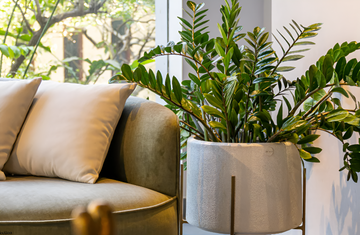Areca palm plants, also known as Dypsis lutescens or butterfly palms, are popular choices for indoor and outdoor plant enthusiasts alike. With their graceful fronds and air-purifying qualities, these tropical plants can thrive in a wide range of environments. They also act as a green wall if you’re looking for some privacy in your balcony or garden. To ensure your Areca palm plants stay healthy and vibrant, it's crucial to provide them with the right care. In this blog post, we will guide you through essential tips on how to care for your Areca palm plants, ensuring their longevity and beauty.
Care Tips for Your Areca Palm Plants
Lighting | Watering | Potting | Fertilizing | Pruning | Pest Control | Planters Recommendation
Lighting Requirements
Areca palms thrive in bright, indirect light. Place your plant pot near a window with filtered sunlight, as direct sunlight can scorch its leaves. In low light conditions, the growth rate may slow down, so aim for a balance between light and shade.
(back to top)
Watering

Proper watering is crucial for the health of your Areca palm. Water the plant thoroughly, allowing the water to drain out from the bottom of the planter. Ensure the top inch of soil feels dry before watering again. Overwatering can lead to root rot, so it's essential to strike a balance and avoid waterlogging, place it in a planter with a good drainage hole.
(back to top)
Soil and Potting
Areca palms thrive in well-draining soil. A mixture of peat moss, perlite, and sand provides adequate drainage. Do not use red soil for your Areca palm. This prevents the root from growing and therefore kills the plant. Choose a planter with drainage holes to prevent waterlogged roots. Repotting should be done when the roots have outgrown the current planter, typically every two to three years. Large Areca Palms require large planters to make sure they thrive.
(back to top)
Fertilizing
Fertilise your Areca palm plants regularly during the growing season that is early summer. A balanced liquid fertiliser, diluted to half-strength, should be applied every two to four weeks. Avoid over-fertilisation , as it can lead to burned roots and leaf tips. During winter months, reduce the frequency of fertilisation. Similarly, same fertilization pattern is followed for Bamboo Palm and Traveler's Palm.
(back to top)
Pruning and Maintenance

Areca palms may require occasional pruning to maintain their shape and remove any yellow or brown fronds. Trim only the damaged or dead leaves and avoid cutting into the green parts of the plant. Regular dusting of the leaves will also help keep them clean and allow for better light absorption.
(back to top)
Pest Control

Areca palms can be vulnerable to mealybugs, spider mites, and scale insects. Regularly inspect your plants for signs of infestation, such as webbing or sticky residue. In case of an infestation, use appropriate organic or chemical insecticides to control the pests. If the pests are just starting out, use a concoction of neem oil and water. The recommended dosage is 1:100, i.e. 1ml of oil to 100ml of water or 2.5ml for 250ml of water. The active ingredients in neem oil begin to decompose after being mixed with water.
With the right care and attention, your Areca palm plants will flourish, bringing a touch of the tropics to your indoor or outdoor space. Remember to provide them with adequate lighting, the right temperature and humidity, and proper watering and fertilisation. Regular pruning and pest control will help maintain their health and beauty. By following these essential care tips, you can enjoy the lush green foliage and vibrant presence of your Areca palms for years to come. Happy gardening!
(back to top)
FAQ Questions about Areca Palm
1. Are Areca Palms toxic to pets?
The areca palm is considered a safe houseplant for pets, as it is not toxic to dogs and cats.
2. What is the lifespan of the Areca plam when placed indoors?
Indoor areca plants typically have a lifespan of approximately ten years, making them relatively short-lived houseplants.
3. What are the common problems that may arise with Areca Palms?
Common problems that may arise with areca palms include leaf tip burn, which manifests as tips and leaves turning yellow or brown. This issue can be attributed to factors such as exposure to chilly air, overwatering, underwatering, poor soil conditions, or compacted roots. These problems can affect both indoor and outdoor areca palms, making it crucial to carefully monitor and maintain the plant's environment to prevent or address these issues.
4.How often should the Areca Palm be watered?
Areca palms should be watered when the soil or potting mix has dried out slightly. They tolerate low soil moisture but thrive in moist soil; however, they are sensitive to overwatering and should not be waterlogged or left in a water-saturated potting mix. It is essential to allow the soil to dry out between waterings to prevent any potential damage to the plant.
Planters recommended for Areca Palm
Discover more planters for your Areca Palm










 At Palasa, we believe in the seamless fusion of nature, design and humanity.
At Palasa, we believe in the seamless fusion of nature, design and humanity.